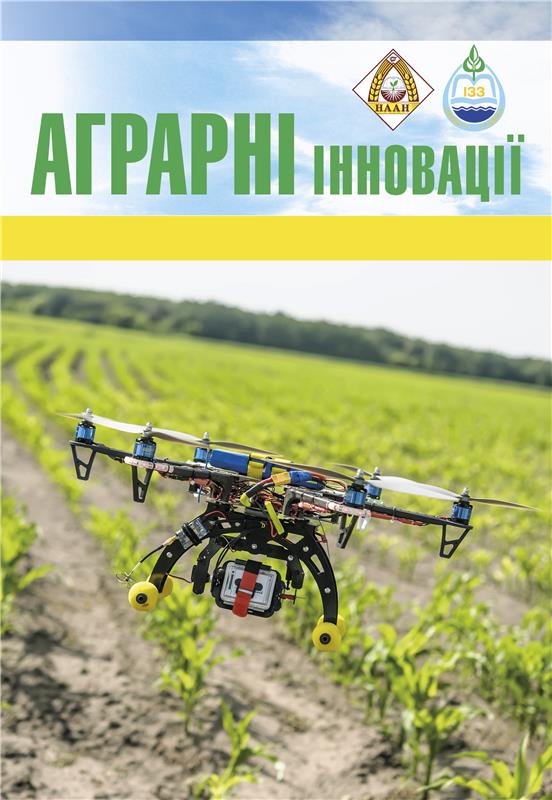BREEDING VALUE OF WINTER WHEAT VARIETIES ACCORDING TO ECONOMIC AND BIOLOGICAL CHARACTERS IN THE RIGHT BANK FOREST STEPPE
Abstract
Purpose. Determination of regularities of varieties of soft winter wheat according to their economic value, their adaptability (plasticity and stability), variation, homeostaticity, variability of a complex of signs, late origin according to signs of productivity. Methods. Field and laboratory methods for studying the variability of economic and valuable characteristics of winter wheat, mathematical methods for the reliability of the obtained data. In the process of conducting research, general scientific and special methods were used: field, which was supplemented by laboratory, to establish the relationship between the object of research and measures of influence on it; mathematical and statistical – to determine the reliability of the obtained results.Results. Selection and genetic protection against the action of biotic factors provides for the extraction of strong sources with effective resistance genes. It is practically impossible to create systems that are resistant to all limited factors, but if you underestimate the importance of at least one of the signs of adaptability, it can lead to unforeseenconsequences. Therefore, determining the reaction of genotypes to changes in environmental conditions must be carried out at all stages of the selection process. The concept of developmental homeostasis characterizes the ability of the genotype to support the stability of processes that are influenced by environmental conditions. The mechanism of homeostasis makes it possible to determine the limits of variability and characteristics of production processes within the limits of the genetic norm of post-reaction. It is believed that the definition of homeostatic parameters makes it possible to evaluate not only their productivity according to the average yield, but also to determine the rate of their reaction to changes in environmental conditions. Conclusions.On the basis of the conducted research, it was established that the average productivity of the Podolyanka standard variety in the forest-steppe zone for two years was 7.2 t/ha.The maximum indicator was provided by the KVS Jersey variety with a yield of 7.9 t/ha (2023) and 7.6 t/ha (2024).The rest of the varieties also exceeded the standard for this indicator Akter – 7.7 t/ha (2023) and 7.3 t/ha (2024). The yield of the MIP Knyazna variety was practically at the same level as the standard – 7.5 t/ha. The following cultivars had the highest grain yield: Ronin (56.1), Jersey (50.6), and Akter (48.2). According to this feature, these varieties significantly exceeded the standard. The standard was slightly exceeded by the MIP Valencia variety (42.1 pcs.), as well as the MIP Knyazna variety (44.5 pcs.). The maximum indicator was provided by the KVS Jersey variety with a grain weight of one ear of 1.89 g (2023) and 1.81 g (2024). The rest of the varieties also exceeded the standard for this indicator Akter – 1.85 g (2023) and 1.74 (2024). Almost at the same level as the standard, the MIP Knyazna variety provided grain weight indicators from an ear of corn – 1.78 g (2020) and 1.71 g (2024).
References
2. В.Т. Александров та ін. Зерновий та хлібопродуктовий товарообіг в Україні: енцикл. довід.: АртЕк, 2000. 544 c.
3. Гадзало Я.М., Кириченко В. В., Дзюбецький Б. В. Стратегія інноваційного розвитку селекції і насінни-цтва зернових культур в Україні: наук. вид. Київ– Харків–Дніпро. 2016. 32 с.
4. Баган А. В., Юрченко С. О., Шакалій С. М. Мінливість потомства різних морфологічних частин колоса сортів пшениці озимої за кількісними ознаками. Вісник Полтавської державної аграрної академії. 2012. No 4. С. 33–355.
5. Сайко В. Ф. Перспективи виробництва зерна в Україні. Вісник аграрної науки. 1997. No 9. С. 27–32.
6. Бурденюк-Тарасевич Л. А., Лозінський М. В., Дубова О. А. Особливості формування довжини стебла у селекційних номерів пшениці озимої залежно від їх генотипів та умов вирощування. Агробіологія.2015. No 1. С. 11–15.
7. Egamov I. U., Siddikov R. I., Rakhimov T. A., Yusupov N. K. Creation of high-yielding winter wheat varieties with high yield and grain quality suitable for irrigated Conditions. International Journal of Modern Agriculture. 2021. No 10(2). Р. 2491–2506.
8. M. Lozinskiy et al. Evaluation of selected soft winter wheat lines for main ear grain weight. Agronomy Research. 2021. Vol. 19. No 2. Р. 540–551. DOI: 10.15 159/ar.21.071
9. С. О. Хоменко та ін. Адаптивний потенціал вихідного матеріалу для селекції пшениці м’якої ярої. Фактори експериментальної еволюції організмів. 2017. Вип. 21. С. 221–224. DOI: 10.7124/FEEO.v21.839
10. В. М. Гудзенко та ін. Селекція ячменю ярого на під-вищення продуктивного та адаптивного потенціалу. Селекція і насінництво. 2017. Вип. 111. С. 51–60.
11. Лозінський М. В., Бурденюк-Тарасевич Л. А., Дубова О. А. Типи успадкування кількості зерен з рослини у гібридів F1 і формотворчий процес в гібридних популяціях F2 пшениці м’якої озимої, отри-маних від гібридизації різних екотипів. Агробіологія. 2016. No 2(128). С. 45–51. URL: http://rep. btsau.edu.ua/ handle/BNAU/1579
12. Бурденюк-Тарасевич Л. А., Лозінський М. В. Принципи підбору пар для гібридизації в селекції озимої пшениці T. aestivum L. на адаптивність до умов довкілля. Фактори експериментальної еволю- ції організмів. 2015. Т. 16. С. 92–96.
13. Животков Л. О., Шелепов В. В., Коломієць Л. А., Чебаков М. П. Завдання, методи, результати селекції інтенсивних сортів озимої пшениці. Генетика і селекція в Україні на межі тисячоліть: у 4 т. / редкол.: В. В. Моргун (гол. ред.) та ін. Київ : Логос, 2001. Т. 2. С. 394–397.
14. Власенко В. А., Кочмарський В. С., Колючий В. Т., Коломієць Л. А., Хоменко С. О., Солона В. Й. Селекційна еволюція миронівських пшениць. Миронівка, 2012. 330 c.
15. Коломієць Л. А., Гуменюк О. В., Юрченко Т. В., Замліла Н. П., Пірич А. В. Прояв адаптивних ознак у генотипів пшениці м’якої озимої за різних гідро-термічних умов. Миронівський вісник. 2018. Вип. 6. С. 6–29.
16. Литвиненко М. А. Удосконалення програми селекції сортів озимої м’якої пшениці універсального типу для умов Півдня України в зв’язку зі змінами клімату. Збірник наукових праць СП-НЦНС. 2010. Вип. 16(56). С. 9–22.






